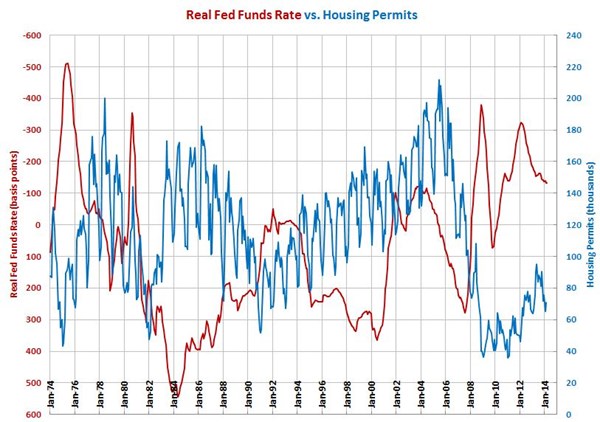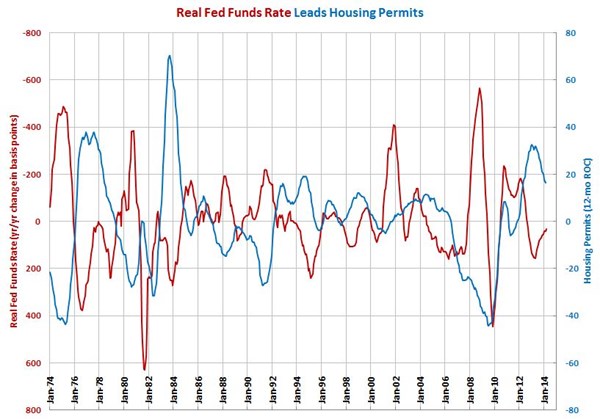Real Fed Funds Rate Unchanged from Last Month
Unless the rate of inflation begins to increase, the change in the real Fed funds rate will begin to stagnate in the next couple of months.
#economics
The real Fed Funds rate was -1.32% in March. The real rate was unchanged from February and remains the highest the real Fed funds rate has been since August 2010. Generally, the rate has been moving higher since February 2012. The year-over-year change in the Fed funds rate has been falling (moving up on the chart below) since April 2013. This trend in rates should provide a temporary boost to the housing market and the market for durable goods purchased with debt.
However, it is unlikely that the change in the Fed funds rate will push into negative territory (that is, the rate dropping from where it was one year ago). This is because the Fed funds rate is essentially zero and the rate of inflation is not increasing, which would help drive down the real Fed funds rate. In fact, the annual rate of inflation in March according to the CPI was 1.51%. Inflation has been 1.5% for three of the last four months. And, since November 2012, the annual rate of inflation has averaged 1.5%. In other words, based on the official rate of inflation, the Fed has been unable to increase price inflation despite all of its money printing. Unless the rate of inflation begins to increase, the change in the real Fed funds rate will begin to stagnate in the next couple of months. Therefore, the trend in interest rates will no longer be supportive of increased spending in the housing and durable goods markets.
The Fed funds rate is an important leading indicator for the following industries: appliances; automotive; custom processors; furniture manufacturing; hardware; HVAC; metalcutting job shops; off-road and construction machinery; petrochemical processors; plastics and rubber; pumps, valves, and plumbing products; textiles, clothing, and leather goods; and wood and paper.


RELATED CONTENT
-
Inside Ford
On this edition of “Autoline After Hours” Joann Muller, Detroit bureau chief for Forbes, provides insights into what she’s learned about Ford, insights that are amplified on the show by our other panelists, Stephanie Brinley, principal analyst at IHS Markit who specializes in the auto industry, and Todd Lassa, Detroit Bureau Chief for Automobile.
-
On The German Auto Industry
A look at several things that are going on in the German auto industry—from new vehicles to stamping to building electric vehicles.
-
China and U.S. OEMs
When Ford announced its 3rd quarter earning on October 24, the official announcement said, in part, “Company revenue was up 3 percent year over year, with net income and company adjusted EBIT both down year over year, primarily driven by continued challenges in China.” The previous day, perhaps as a preemptive move to answer the question “If things are going poorly in China, what are you doing about it?, Ford announced that it was establishing Ford China as a stand-alone business unit.


.JPG;width=70;height=70;mode=crop)